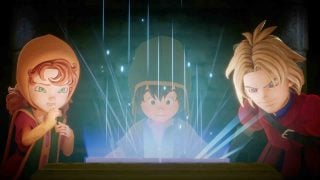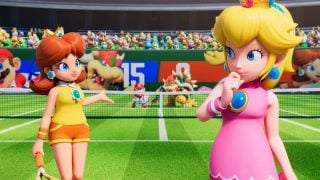Sega and Nintendo have had a long history, and while they may be on better terms now, retro gamers will no doubt remember the bitter rivalry that dominated the late ‘80s and early ‘90s. In this new article series, “Sega Sunday,” we’ll look back on this era and learn more about Nintendo’s oldest rival.
No game quite shows the contrast between Nintendo and Sega like the weird and wonderful Space Harrier. Originally released in arcades during December 1985, the game is a rail shooter where you control a man who can inexplicably fly as he blasts his way across surreal alien planets with weird names like Moot and Olisis.
This genre might sound typical of arcade games at the time, but Space Harrier stood out by being a visual masterpiece. Using the 3D scrolling techniques Sega pioneered for their racing game Hang-On, Space Harrier flings you forward at breakneck speed as you avoid colliding with scaling sprites rapidly coming up from the horizon. The arcade board Sega created for the game was the most powerful of its kind at the time, and it shows.

Space Harrier wasn’t just visually phenomenal either; special mention must be given to its sound design. Composer Hiroshi Kawaguchi was behind many unforgettable Sega tunes of the era, and his Space Harrier theme is no exception. The game was also one of the first major titles to feature digitized speech, with the opening line – “Welcome to the Fantasy Zone. Get ready!” – enduring in the memories of Sega fans to this day.
As was the case with many mid-’80s arcade games, Space Harrier did see a wide-release on home platforms. Naturally the Sega Master System got one of the first versions, which was later ported to the Game Gear, but owners of the Commodore 64, Amiga ST, PC Engine and many more, also got to experience the title, with varying degrees of accuracy and faithfulness.
In a bizarre turn of events even Nintendo’s own Famicom got a version (see below), although only in Japan. This was a time before the 16-bit console war began in earnest, so a few Sega games did end up on Nintendo’s system, like AfterBurner and Shinobi, although these ports were developed by third parties like Sunsoft and Tengen.

Fans of Bayonetta will also remember the chapter of the first game that features not only a reference to the aforementioned “Fantasy Zone” line, but similar gameplay and an incredible remix of the Space Harrier theme. Platinum Games also included a similar throwback in one of the closing chapters of the Wonderful 101, although it was a little more subtle.



